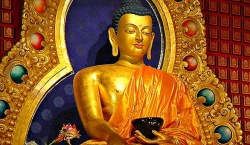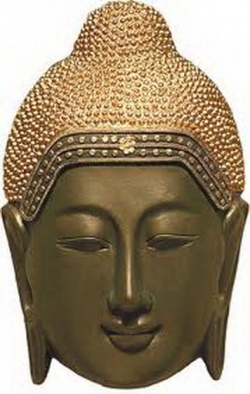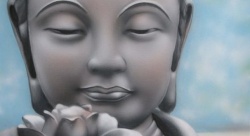Humanistic Buddhism
Humanistic Buddhism (Chinese: 人間佛教; pinyin: rénjiān fójiào) is a modern Buddhist philosophy practiced mostly by Mahayana Buddhists. It is the integration of people's spiritual practice into all aspects of their daily lives . Buddhist monastics such as Taixu and Yinshun are seen as earlier pioneers of the movement , which was later migrated to Taiwanese Buddhism through other Buddhist leaders, such as Cheng Yen, Hsing Yun and Sheng Yen.
Humanistic Buddhism claims to encompass all of the Buddhist teachings from the time of Gautama Buddha to the present. Its goal is to live the bodhisattva way, which means to be an energetic, enlightened, and endearing person who strives to help all sentient beings liberate themselves. It focuses on issues of the world rather than on how to leave the world behind; on caring for the living, rather than the dead; on benefiting others, rather than benefiting oneself and on universal salvation, rather than cultivation for only oneself.
This orientation reflects the fundamental spirit of the Lotus Sutra. Central to this philosophical stance is an essentially optimistic belief in the core dignity of humans, and their ability to transform themselves in a positive way.
Humanistic Buddhism is a based on the fundamental awareness of the interconnectedness of self and others , a state of enlightenment which overrides distinctions between human beings - and focuses on their core “oneness”, their humanity . The oneness of self and others is the background of altruism and of the aspiration to help others lead a life free from sufferings: “The Bodhisattva exemplifies the state of compassion, or altruistic life, and a person in this state aspires to help all people gain happiness, seeking in Nichiren’s words ‘to attain enlightenment only after having first saved others from sufferings’.”
Nomenclature
Taixu, a reformist pioneer in early 20th century Chinese Buddhism, was one of the first to popularize the term "Buddhism for Human Life" (Chinese: 人生佛教; pinyin: rénshēng fójiào), though may not have been the inventor of this term. The first two characters, "human" and "life", indicating his criticism of several aspects of late Ming dynasty and early Republican Chinese Buddhism that he wished to correct, namely, an emphasis on spirits and ghosts (viz "human"), and funeral services and rites (viz "life"). His disciples continued this emphasis.
Taixu also used the term "Buddhism for the Human World", or popularly "Humanistic Buddhism" (Chinese: 人間佛教; pinyin: rénjiān fójiào). It appears that at first the two terms were largely interchangeable. One of Taixu's disciples, Yin Shun, used the term "Humanistic Buddhism" to indicate a criticism against the "deification" of Buddhism, which was another common feature of much of Chinese Buddhism, in his articles and books. It was Yinshun, and other disciples of Taixu, who brought both of these two terms to Taiwan in the wake of the Republican's defeat during the civil war against the Chinese Communist Party. It was in Taiwan that the term "Humanistic Buddhism" became the most commonly used term, particularly amongst the religious leaders who originally hailed from China.
The term 人間佛教 (pinyin: rénjiān fójiào) has also been translated as "Engaged Buddhism" or "Socially Engaged Buddhism," attributed mainly to Thich Nhat Hanh and his rendering of the Chinese into Vietnamese as Nhân gian phật giáo. Both share historical and structural features in emphasizing the relief of suffering in the here and now. An international conference on "Humanistic and Engaged Buddhism - Patterns and Prospects" was held May 18–24, 2009 at Foguang University in Ilan, Taiwan to reflect on the history, teachings, practices, and future of these movements.
Pure Land in the human world
The proponents of this reformation was not seen as a rejection of other forms of Buddhism, but a reinterpretation. One classic example, is the idea of "creating a Pure Land in the human world" (Chinese: 建設人間淨土; pinyin: jiànshè rénjiān jìngtǔ), which can be seen as a new interpretation to the Pure Land form of Chinese Buddhism. This latter school, of course, being one of the most popular forms of Chinese Buddhism for over 1000 years, particularly amongst the laity. Many of the forms and practices are maintained, however, the aim is redirected - rather than practicing in the hope (or vow) of rebirth in Amitabha Buddha's Pure Land, the practitioner seeks to better themselves and society, to create a Pure Land here on earth. This interpretation is also quite well justified in many Mahayana scriptures , which indicate that the bodhisattva (Mahayana practitioner) "travels from Pure Land to Pure Land, learning from the Buddhas and bodhisattvas", before creating their own one, as an expedient means to liberate sentient beings.
Humanistic teaching in Nichiren Buddhism
Nichiren Buddhism is based on the Lotus Sutra, one of the major Mahayana sources, in which the Buddha declared equality of all human beings and introduced the teaching of Buddha Nature as common to all people. Nichiren viewed that the essence of the Lotus Sutra as expression of humanism: “the Lotus Sutra that leads all people to Buddhahood, and we ordinary human beings are in no way different or separate from one another. and viewed the Buddha as a role model for all humanity: “The purpose of the appearance in this world of Shakyamuni Buddha, the lord of teachings, lies in his behavior as a human being”.
According to modern Buddhist movement of Nichiren Buddhism, the essence of Buddhist humanism lies in treasuring diversity: “The humanism of the Lotus Sutra comes down to the tenet of treasuring the individual” and in valuing the individual human being: “To place supreme value on the human being is the teaching of the Lotus Sutra. It is the humanism of the Buddhist Law”. which coincide with the belief that each person has the potential for Buddhahood
Current activities of Buddhist Humanism
Sharing the ideal of global citizenship and the oneness of all humanity is practiced by various Buddhist activities around the globe. In one of its practical meaning on the world stage, Buddhist humanism strives to spread peace and oppose threats to humanity’s survival. Another aspect of manifesting the teaching of Humanistic Buddhism is the interfaith dialogue and the study of the common tenets of non-violence.
Six characteristics
According to Hsing Yun, Humanistic Buddhism has the following six characteristics:
- Humanism
- The Buddha was neither a spirit--coming and going without leaving a trace-- nor a figment of one’s imagination. The Buddha was a living human being. Just like the rest of us, he had parents, a family, and he lived a life. It was through his human existence that he showed his supreme wisdom of compassion, ethical responsibility, and prajna-wisdom. Thus, he is a Buddha who was also (in the past) a human being.
- Emphasis on daily life
- In his teachings, the Buddha placed great importance on daily life as spiritual practice. He provided guidance on everything, from how to eat, dress, work, and live, to how to walk, stand, sit, and sleep. He gave clear directions on every aspect of life, from relations among family members and between friends to how we should conduct ourselves in the social and political arenas.
- Altruism
- The Buddha was born into this world to teach, to provide an example, and to bring joy to all beings. He nurtured all beings, for he always had the best interests of others in his mind and heart. In short, his every thought, word, and action arose from a heart filled with deep care and concern for others.
- Joyfulness
- The Buddhist teachings give people joy.
- Timeliness
- The Buddha was born for a great reason: to build a special relationship with all of us who live in this world. Although the Buddha lived some 2,500 years ago and has already entered nirvana, he left the seed of liberation for all subsequent generations. Even today, the Buddha’s ideals and teachings serve as timely, relevant guides for us all.
- Universality
- The entire life of the Buddha can be characterized by the Buddha’s spirit of wanting to liberate all beings, without exclusion. [The Buddha loved beings of all forms, whether they were animals or humans, male or female, young or old, Buddhist or not Buddhist, etc.]
In Taiwan
Yinshun was the key figure in the doctrinal exposition of Buddhism, and thus Humanistic Buddhism, in Taiwan. However, he was not particularly active in the social or political spheres of life. This was to be carried out by a younger generation: Hsing Yun, Sheng-yen, Wei Chueh and Cheng Yen. These four figures, collectively known as the "Four Heavenly Kings of Taiwanese Buddhism", head the "Four Great Mountains", or monasteries, of modern Taiwanese Buddhism: Fo Guang Shan, Dharma Drum Mountain, Chung Tai Shan, and Tsu Chi.
Source
Wikipedia:Humanistic Buddhism
[[Category:Taiwan
]]


